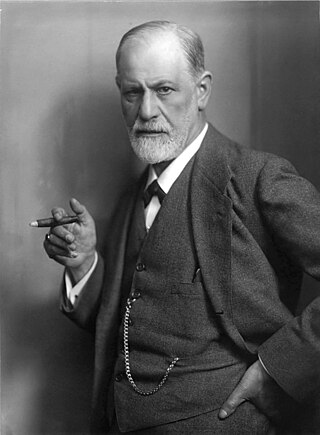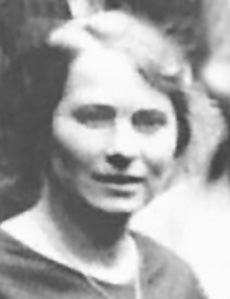
Sigmund Freud was an Austrian neurologist and the founder of psychoanalysis, a clinical method for evaluating and treating pathologies seen as originating from conflicts in the psyche, through dialogue between patient and psychoanalyst, and the distinctive theory of mind and human agency derived from it.

Alfred Ernest Jones was a Welsh neurologist and psychoanalyst. A lifelong friend and colleague of Sigmund Freud from their first meeting in 1908, he became his official biographer. Jones was the first English-speaking practitioner of psychoanalysis and became its leading exponent in the English-speaking world. As President of both the International Psychoanalytical Association and the British Psycho-Analytical Society in the 1920s and 1930s, Jones exercised a formative influence in the establishment of their organisations, institutions and publications.

Karl Abraham was an influential German psychoanalyst, and a collaborator of Sigmund Freud, who called him his 'best pupil'.

Sabina Nikolayevna Spielrein was a Russian physician and one of the first female psychoanalysts. She was in succession the patient, then student, then colleague of Carl Gustav Jung, with whom she had an intimate relationship during 1908–1910, as is documented in their correspondence from the time and her diaries. She also met, corresponded, and had a collegial relationship with Sigmund Freud. She worked with and psychoanalysed Swiss developmental psychologist Jean Piaget. She worked as a psychiatrist, psychoanalyst, teacher and paediatrician in Switzerland and Russia. In a thirty-year professional career, she published over 35 papers in three languages, covering psychoanalysis, developmental psychology, psycholinguistics and educational psychology. Among her works in the field of psychoanalysis is the essay titled "Destruction as the Cause of Coming Into Being", written in German in 1912.
The International Psychoanalytical Association (IPA) is an association including 12,000 psychoanalysts as members and works with 70 constituent organizations. It was founded in 1910 by Sigmund Freud, from an idea proposed by Sándor Ferenczi.
The Berlin Psychoanalytic Institute was founded in 1920 to further the science of psychoanalysis in Berlin. Its founding members included Karl Abraham and Max Eitingon. The scientists at the institute furthered Sigmund Freud's work but also challenged many of his ideas.
Medard Boss was a Swiss psychoanalytic psychiatrist who developed a form of psychotherapy known as Daseinsanalysis, which united the psychotherapeutic practice of psychoanalysis with the existential phenomenological philosophy of friend and mentor Martin Heidegger.
A lay analysis is a psychoanalysis performed by someone who is not a physician; that person was designated a lay analyst.
A training analysis is a psychoanalysis undergone by a candidate as a part of her/his training to be a psychoanalyst; the (senior) psychoanalyst who performs such an analysis is called a training analyst.
Peter J. Loewenberg is an American historian and psychoanalyst, professor of "European cultural, intellectual, German, Austrian and Swiss history, political Psychology, integrating the identities of an historian and political psychologist with the clinical practice of psychoanalysis" at UCLA.
The Paris Psychoanalytical Society (SPP) is the oldest psychoanalytical organisation in France. Founded with Freud’s endorsement in 1926, the S.P.P. is a component member of the International Psychoanalytical Association (I.P.A.) as well as of the European Psychoanalytical Federation (E.P.F.).

Hanns Sachs was one of the earliest psychoanalysts, and a close personal friend of Sigmund Freud. He became a member of Freud's Secret Committee of six in 1912, Freud describing him as one "in whom my confidence is unlimited in spite of the shortness of our acquaintance".

Ernst Simmel was a German-American neurologist and psychoanalyst.
The Sigmund Freud Institute (SFI) is a research institute for psychoanalysis located in Frankfurt, Germany. It was established in 1960 as an institute and training center for psychoanalysis and psychosomatic medicine. Renamed in 1964, it is now called after Sigmund Freud, the founder of psychoanalysis. Since 1995, the institution has been dedicated entirely to research.
Mary Chadwick was a British nurse and psychoanalyst, characterised by Edward Glover as "the founder of child-analysis in Britain". A friend of the poet H.D., she analysed their work in 1931.

John Friedrich Karl Rittmeister, often also abbreviated John F. Rittmeister, was a German neurologist, psychoanalyst and resistance fighter against Nazism. Rittmeister was a humanist and socialist who based his opposition to the Nazi state on moral grounds. He was known as a communist member of the anti-fascist resistance group that was later called the Red Orchestra by the Abwehr.
Salomea Kempner (1880–1940?) was a Polish psychoanalyst, assistant physician at the Cantonal Insane Asylum in Rheinau, Switzerland.
The Israel Psychoanalytic Society is the official psychoanalytic organization in Israel, a constituent member of the International Psychoanalytic Association, founded in 1933.
Josine Müller was a German medical doctor and psychoanalyst. She was born on October 10, 1884, in Hamburg and died on December 30, 1930, on a voyage to the Canary Islands.
Mira Oberholzer-Gincburg,, was a Swiss medical doctor and psychoanalyst of Russian-Polish origin. A pioneer of psychoanalysis in general and child psychology in particular, she was a founding member of the Swiss Society of Psychoanalysis in 1919, and worked in Switzerland and the United States as a child analyst.







